Gaia Asteroid Census
August 8, 2022
One
method that
governments have to monitor
demographic trends in their
countries is by
census. In the
United States, a census is
legally mandated by the
U.S. Constitution, and a census has taken place every
decade since
1790. To encourage
honest reporting, answers to census questions are
confidential. No one is allowed to associate any
person,
household, or
business with
identifiable information.
One
controversy of the US Census process is its extended data collection beyond that required to
apportion the
House of Representatives of the
United States Congress. One year, I was asked to give the number of
toilets in my
house! The answer is
only two, which pales in comparison to the supposed number in
Buckingham Palace. That
residence has 78
bathrooms and likely as many toilets.
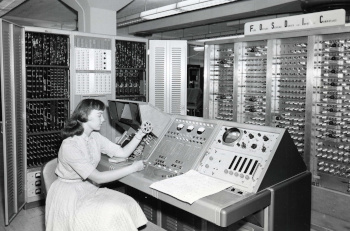
A census tabulator from 1960s. Note the wall of vacuum tubes on the right.
Shown is the FOSDIC (Film Optical Sensing Device for Input to Computers), with possible reference to Fearless Fosdick, a parody of the Dick Tracy comic strip of Chester Gould (1900-1985) that appeared in the Li'l Abner comic strip by Al Capp (1909-1979).
The name most associated with census tabulating machines is Herman Hollerith (1860-1929), who developed an electromechanical tabulating machine for punched cards used in the 1890 United States census.
FORTRAN programmers will remember Hollerith constants, a way to insert character data into their programs. The code 7HTIKALON is the way that the seven character string, TIKALON, was printed (early impact printers could print just upper-case characters).
(Wikimedia Commons image from U.S. Census Bureau. Click for larger image.)
Our
Solar System has eight
planets, along with their many
moons, and
probably nine dwarf planets, the largest of which is the
demoted planet,
Pluto. These are listed below.
The total number of these large bodies pales in comparison with the number of known
asteroids and the estimated much greater number of unknown asteroids. It's
estimated that there are millions of asteroids, most of the known asteroids being found in the
main asteroid belt between the
orbits of
Mars and
Jupiter. There are more than 200 asteroids larger in
diameter than 100
kilometers (60
miles) in the main asteroid belt, but there might be 1-2 million asteroids larger than 1 kilometer (0.6 miles), and millions of smaller ones.
There are asteroid
populations besides the main asteroid belt. The
Trojan asteroids orbit the
Sun in the same orbits as a planet at its
Lagrange points. These are locations about 60
degrees ahead or behind the planet at which the
gravitational pull of the planet
balances that of the Sun. Jupiter, the largest planet, has a
retinue of more than 10,000 Trojan asteroids, while
Neptune has 30, and Mars has 9.
Uranus and
Earth each have just a single discovered Trojan.
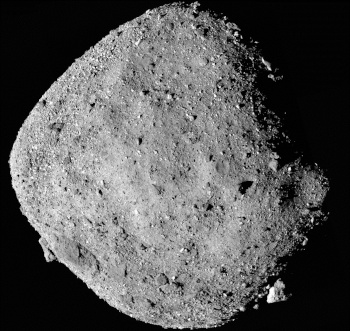
A mosaic image of the asteroid, 101955 Bennu, composed from images collected on December 2, 2018, by the OSIRIS-REx spacecraft from a range of 24 kilometers (15 miles).
Bennu, an Apollo asteroid, is a carbonaceous asteroid of mean diameter of 490 meters, and it has a cumulative 1-in-1,800 chance of impacting Earth between 2178 and 2290 with the greatest risk being on September 24, 2182.
The OSIRIS-REx spacecraft successfully collected a sample of Bennu for return to Earth.
(Wikimedia Commons image by NASA/Goddard Space Flight Center/University of Arizona. Click for larger image.)
The
Apollo asteroids, named after the first discovered of this class,
1862 Apollo, are asteroids whose orbits cross Earth's orbit. There are presently more than 10,000 known Apollo asteroids, and about the same number of other
near-Earth asteroids that aren't Apollo asteroids. More than 2,000 near-Earth asteroids, about three-quarters of which are Apollo asteroids, are sufficiently large enough to be hazardous if they impact Earth. As an example, the
Chelyabinsk meteor that exploded over
Chelyabinsk, Russia, on February 15, 2013, was an Apollo asteroid. NASA's
Center for Near-Earth Object Studies monitors such objects.
There is reason enough beyond
scientific curiosity to do a careful census of Solar System asteroids, and the
Gaia space observatory of the
European Space Agency is conducting such a census. Gaia was
launched in
2013 and it is expected to operate until 2025. The Gaia spacecraft was designed primarily for
astrometry, the
measurement of the the
positions,
distances and
motions of
stars, but it tracks all
points of
light visible to its
sensors, and these include asteroids and
comets.
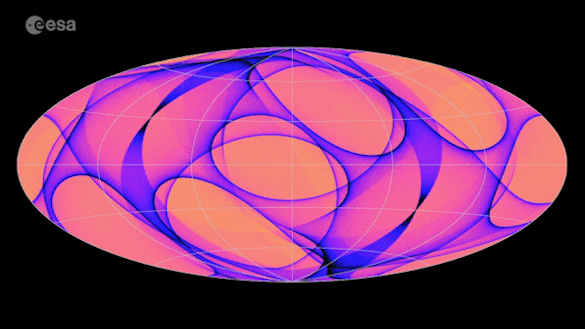
Looking very much like modern art this is a visualization of Gaia's sky coverage. (A still frame from a Wikimedia Commons image by B. Holl of the University of Geneva, Switzerland, and A. Moitinho and M. Barros of CENTRA, University of Lisbon.)
Gaia's first data release to the
Gaia Archive, done after its first 14
months of operation,
cataloged the positions and
magnitudes for 1.1 billion stars.[2] The second data release cataloged the positions,
parallaxes and
proper motions for about 1.3 billion stars, the positions of an additional 300 million fainter stars, and some asteroid data.[1-2] The most recent data release of June 13, 2022, includes data on Solar System objects, including a ten-fold increase in the number of cataloged asteroids.[1-2]
Gaia resides about 1,5 million kilometers from the Earth near the
Sun-Earth Lagrange L2-point.[1] Gaia has two
optical telescopes, and it scans the sky by
rotating about its
axis in a
period of about six
hours, and its
instruments allow for accurate determination of object positions, velocities, and
spectra. All this data allows determination of the
chemical compositions,
temperatures,
colors,
masses,
brightness, ages, and
radial velocities of stars and the
physical properties of asteroids.[1] About fifty
scientific articles are being
published coincident with the latest data release.[1]
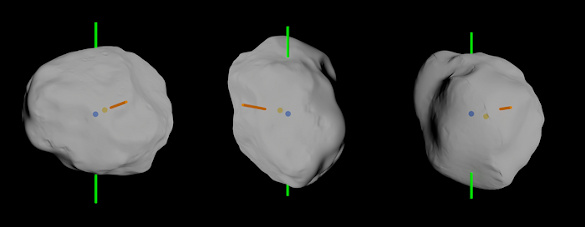
The photocenter of asteroid Lutetia (brown bullet) and center of mass (blue bullet) as viewed by Gaia in three different viewing geometries. The illumination by the Sun is in the direction of the red bar, and the angle between Gaia and the Sun is, from the left to the right, 16.7, 24.2 and 20.9 degrees and the photocenter-barycenter distance is 7.42, 5.96 and 10.91 kilometer, respectively. Image from P. Tanga, K. Muinonen, A. Penttilã, et al., 2022, Astronomy & Astrophysics, in press.
The large number of cataloged asteroids means that there is a significant increase in the number of detected asteroids in
close proximity to each other. Such close encounters allow estimates of asteroid mass.[1] Gaia's astrometry is so accurate that a correction is required for the angular offset between the center of mass of an asteroid and the center of the area illuminated by the Sun.[1]
The latest data release contains about 60,000 spectra of Solar System asteroids (see figure). An asteroid's spectrum allows an estimate of its composition and offers clues to its
origin and the evolution of the Solar System.[1] Gaia has increased the number of available asteroid spectra by more than an
order of magnitude.[1]
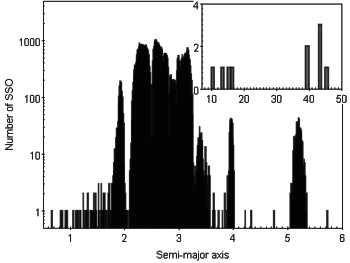
Histogram of the asteroids with spectra in the latest Gaia Data Release, no. 3.
The number of asteroids is in the vertical axis, and the horizontal axis shows the distance of the asteroid to the Sun in astronomical units.
The asteroid belt lies between 2.2 and 3.2 astronomical units, and this is reflected in the histogram data.
(Gaia Collaboration image from L. Galluccio, K. Muinonen, G. Fedorets, M. Granvik, A. Penttilã, L. Siltala, et al., 2022, Astronomy & Astrophysics, in press. Click for larger image.)
Apart from the asteroid observations, a significant result of Gaia's measurements is its data for about 1,6 million
quasars. Such data can be used to create a more accurate visible light
Celestial Reference Frame that will enhance the accuracy of
satellite positioning and measurements by
Earth observation satellites.[1] The present International Celestial Reference Frame (ICRF3) is based on the
radio positions of a few thousand quasars obtained using
very long baseline interferometry (VLBI).[1]
References:
- Gaia space telescope rocks the science of asteroids, University of Helsinki Press Release, June 17, 2022. This press release also appears here.
- Gaia Archive at ESA.
Linked Keywords: Methodology; method; government; demographic; trend; country; countries; census; United States; law; legally mandated; United States Constitution; decade; 1790; honesty; honest; confidentiality; confidential; human; person; household; business; personal identity; identifiable; information; controversy; apportionment; apportion; United States House of Representatives; United States Congress; toilet; home; house; Buckingham Palace; residence; bathroom; census tabulator from 1960; tabulating machine; tabulator; 1960s; vacuum tube; Fearless Fosdick; parody; Dick Tracy; comic strip; Chester Gould (1900-1985); Li'l Abner; Al Capp (1909-1979); Herman Hollerith (1860-1929); electromechanics; electromechanical; punched card; 1890; FORTRAN; programmer; Hollerith constant; alphabet character; data; computer program; source code; string (computer science); impact printer; letter case; upper-case; Wikimedia Commons; Solar System; planet; natural satellite; moon; dwarf planet; Pluto classification; demoted planet; Haumea; Quaoar; Ceres (dwarf planet); Makemake; Gonggong; Eris (dwarf planet); 90482 Orcus; 90377 Sedna; asteroid; approximation; estimate; main asteroid belt; planetary orbit; Mars; Jupiter; diameter; kilometer; mile; statistical population; Trojan (celestial body); Trojan asteroid; Sun; Lagrange point; degree (angle); gravitation; gravitational pull; mechanical equilibrium; balance; retinue; Neptune; Uranus; Earth; mosaic image; 101955 Bennu; digital image; OSIRIS-REx spacecraft; Apollo asteroid; carbon; carbonaceous; probability; chance; impact event; impacting Earth; risk; NASA; Goddard Space Flight Center; University of Arizona; 1862 Apollo; near-Earth asteroid; Chelyabinsk meteor; Chelyabinsk Oblast; Chelyabinsk, Russia; Center for Near-Earth Object Studies; science; scientific; curiosity; Gaia (spacecraft); Gaia space observatory; European Space Agency; rocket launch; launched; 2013; astrometry; measurement; position (vector); distance; motion (physics); star; point (geometry); light; visible spectrum; sensor; comet; modern art; scientific visualization; delestial sphere; sky; still frame; University of Geneva, Switzerland; CENTRA; University of Lisbon; Gaia Archive; month; astronomical catalog; apparent magnitude; stellar parallax; proper motion; Sun-Earth Lagrange L2-point; optical telescope; rotation; rotating; rotation around a fixed axis; frequency; period; hour; measuring instrument; astronomical spectroscopy; spectra; chemical composition; temperature; color; mass; brightness; radial velocity; physics; physical; scientific literature; scientific article; publish; photograph; photocenter; 21 Lutetia; center of mass; geometry; geometries; lighting; illumination; angle; barycenter; proximity; origin and the evolution of the Solar System; order of magnitude; histogram; Gaia Data Release; abscissa and ordinate; vertical axis; horizontal axis; astronomical unit; Gaia Collaboration; Astronomy & Astrophysics; quasar; Celestial Reference Frame; satellite; Earth observation satellite; radio astronomy; very long baseline interferometry (VLBI).